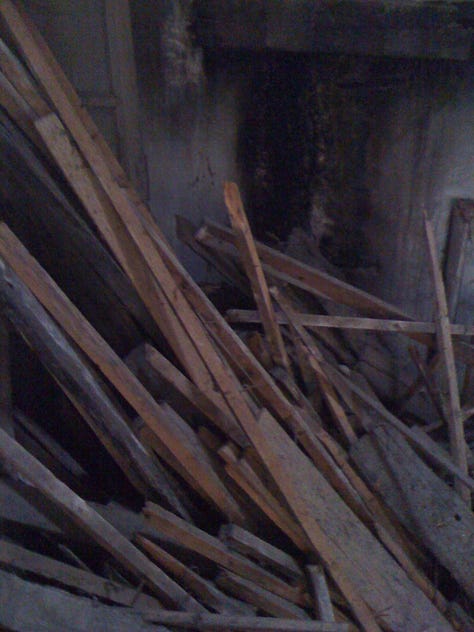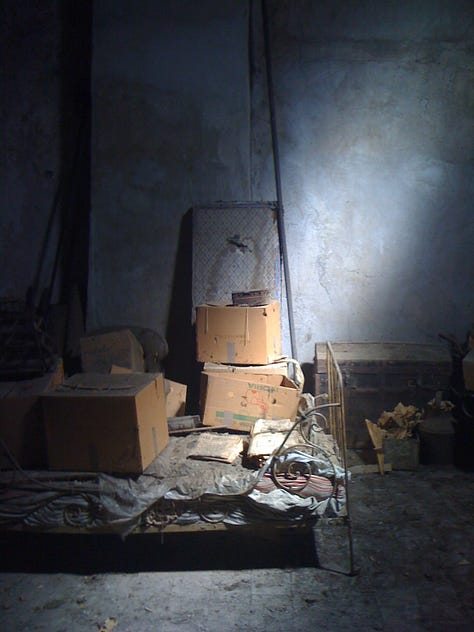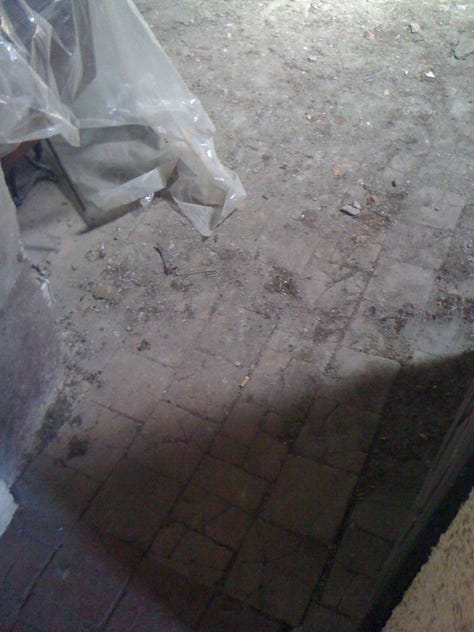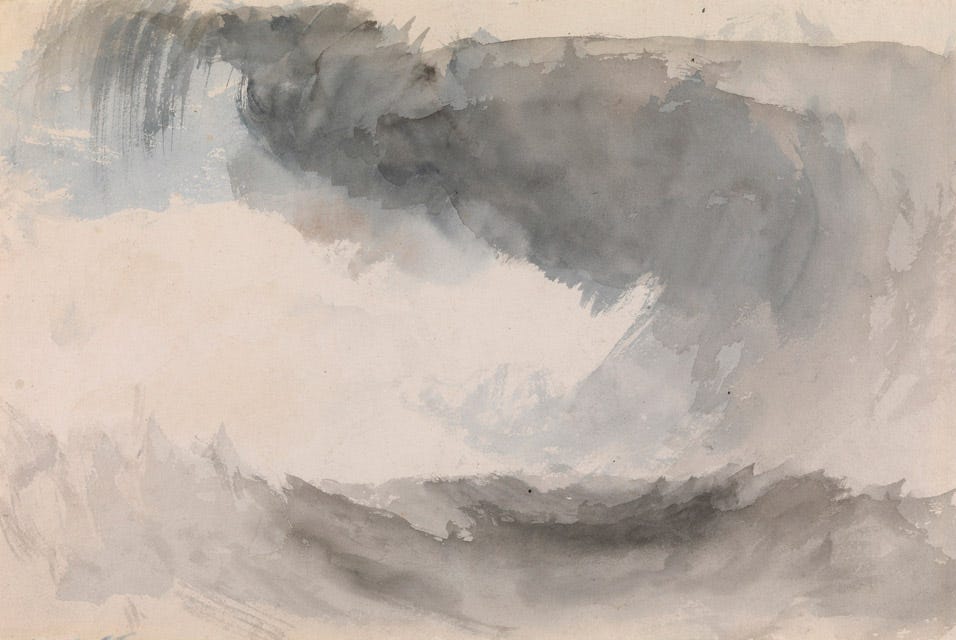#11 'What are you playing?' 'The storm,' she replied
On the flood of the century, a quiet hope and the luminous pianist keeping Emahoy Tsegue Maryam Guebrou's music alive.
The Ethiopian nun, composer and concert pianist, Emahoy Tsegue Maryam Guebrou, once told an interviewer that the piano had been her best friend since she was eight.
As a six year old, she was sent to a Swiss boarding school, where she learned to play the violin. She also learned to play the piano. People there, she said, would often ask her what she was playing.
"The storm," she would reply.
My parents live at the confluence of two rivers, in a village in the Cévennes. The water rises and falls in both, but they mostly pass quietly between boulders the size of small cars.
In the summer, we swim in the larger of the two, the Hérault, mostly upstream from the village but sometimes in the village itself. You put on your river shoes and your swimsuit and walk up our road, past the Catholic church with its fountain and its trees that drop sticky leaves. You pass a stained glass window studio and the oldest construction in town, the Pont de la Confrérie, built in around 1200. The houses on either side of this arched bridge form a tight-knit row that rises right out of the riverbed rocks. Several are built over little tunnelled openings that lead to the water’s edge.
This had long been silkworm country but after a series of extreme cold spells killed most of the region’s olive and chestnut trees in the early 1700s, people started planting white mulberry trees, the insects’ only food source, in earnest. By 1831, the Gard prefecture counted 4.7 million trees*.
Our house, like most, is built of the rivers’ boulders. It boasts fat load-bearing walls a metre thick and a double-height room across one half of the top two floors called the magnanerie. This is where the silkworms were bred. People would light fires in each of the huge, stone-cold room’s four corner fireplaces, to create an atmosphere as warm as tropical swimming water. The silkworm fed on leaves and their cocoons were exported to mills downstream.
These days, heating any part of these houses is a challenge no amount of government eco-subsidy can match. When my parents first moved in, the magnanerie was the most magical room of all, piled high with bundles of wood and timber seemingly left untouched for centuries. Stepping inside was akin to working your way into a Rembrandt. It smelled of time. It made you stand stiller.
My father makes guitars. So he washed the broken floor clay tiles and cleared out the soot and dust and, after backbreaking work doing up the rest of the house so they could live there, he turned his magnanerie into a luthier’s workshop.






He climbs the stairs every day, braving both winter’s chill and summer’s heat, to shape braces and rout binding channels, and listen to the birds roosting in the eves. On a hot summer’s day, baby bats take refuge in the cool behind the shutters. If you look out either window, neither of which close all that well, all you see is green of the Basses Cévennes, these gentle folds of green oak and chestnut and beech and pine.
On September 19 2020, my dad had been watching the rain out those windows for days. Their village is at the foot of the Cévennes’ tallest peak, the Mont Aigoual, 1,567m. Pressure systems from the golfe du Lion get caught on this southern flank of the Massif de l’Aigoual and wreak days of havoc. In the 17th century these épisodes cévenoles were described as divine retribution. In 1900, the village imbibed 950mm in under 10 hours, which is still a national record.
The 2020 storm didn’t drop quite as much, but half of the 718mm total filled the rivers in just four hours. The smaller of the two — the Clarou — reached levels not known for a century.
The Clarou runs alongside a road through a very narrow valley. We like to call this my mother’s road, but actually we all love taking it as much as she does. You inch up it, quiet and forgotten, past the village’s last houses and the Catholic cemetery, between gardens with crumbling walls and pastures laid out beneath plane trees centuries tall, past houses with red shutters and dogs running free, through a bit where the river curves left and the valley opens up to the right, with terrraced hills and forest leading over the crest to even quieter, more barren valleys.
Here in this beautiful double curve where the Clarou stretches out its arms, my friend the photographer Vivianne Dalle lives in a tall house. Further up the hill a shepherd has his winter sheepfold. Another house beyond is built, in part, over the water, like Frank Lloyd Wright’s Fallingwater, only less angular and much, much older.
From there, the valley starts to narrow. There’s another bridge and a curve and a cascade and a hamlet with a saw mill that only one retiree uses — because he’d always wanted one — and then another bridge where, this time, the drop down to the water would scare you if you were scared of heights. And eventually you start to really climb. And everything in you wants to just keep going with that road, until all the houses are out of sight and it’s just you and the green and the quiet in the wind.
The flood of September 2020 destroyed all those bridges. The water rose to flood the road, the gardens, the pastures. It felled trees and stunned farmers who said not even their grandfathers had ever seen it this high. It raced down the valley towards the village, ignoring all boundaries, and hit the bridge at the bottom of my parents’ street, the one where the Clarou meets the Hérault. Everything exploded.
My parents made the video below.
Vivianne — who I aim to interview for you soon — made a very moving body of work on the aftermath of that storm. With patience and attention, she documented the lives and the landscapes it upended.
The commune sagged under 2 million euros worth of damage. A third of its agricultural land was washed away. Eleven bridges had to be rebuilt along with walls and terraces and livelihoods. The last time I was there, new infrastructure was still being installed. Two people lost their lives.
So many people lost a lot of things, the contents of their cellars irredeemably caked in mud and dumped on the pavements. Shops had to relocate because insurance companies would no longer consider their locations insurable. My mother salvaged a broken sewing machine.
If I’d been in the village when the storm happened I know I’d have wanted to go outside. I always do. The worse the weather, the more I want to be out in it. My friend Sabrina sees the world like I do. We’ve donned raincoats and flipflops to go watch the wilding waters in lesser storms. But then on a clear, dry day in the middle of summer, you’ll head back to the same spot and stand confused at the river’s incomparable timidity. A trickle. Rocks pale and hot to the touch. Green algae drying in lines as drought conditions see the water levels drop lower and lower.
Last July, I was walking through the Hérault, as we often like to do, towards the swimming hole we call la cascade, with Elliot, Sabrina’s son, who is 13. They had just come back from cycling around Scandinavia for three months and Elliot wanted to know what had been my highlights of recent months. I told him about going to Venice for the first time.
In April, Shade Podcast asked me to interview John Akomfrah about his British Pavillion installation for the 60th Venice Biennale (on until November 4). You can listen to the interview here**.
Even before I knew anything of John Akomfrah's British Council commission at the 2024 Venice Biennale, I loved it for its title: Listening All Night To The Rain. When I was born, my parents were renting a flat on a farm in northern South Africa. People working on the farm called me Pula, which means "rain" in Sesotho, because they said I'd made my parents as happy as rain in a dry place makes everyone. Of course waking up to the sound of it falling on the roof above my head feels as comforting as home.
But home isn't a comfort for everyone. Nor is every listener to rainfall doing so from under a roof.

Embarking on the audiovisual epic Akomfrah had plotted throughout the British pavilion -- from its façade through to the back entrance with its view of the Venetian lagoon and the Adriatic beyond -- felt, to me, like pushing upstream through floodwaters. It was an onslaught of sound and music and quotes, of documentary footage, of archival materials and staged filmic tableaux. In this multi-room, multi-multi-screen piece, you couldn’t possibly expect to get every reference but it did make you feel quite literally plunged into the waters — geological and metaphorical — depicted on screen. As mesmerising as it was disquieting and upsetting, for its realness. There is such loss, such trauma, written into our collective waters.
While in Venice, my friend Nirith and I went to the Pinault Collection in the Palazzo Grassi to hear Maya Denietz play Guebrou’s music, at the invitation of Julie Mehretu***. Guebrou passed away in 2023. Denietz is an incredible pianist, singer and sound artist, who befriended her before her passing and I will tell you that story another time — hopefully, if she agrees, via an interview.
I’ve thought so much about what it means to reckon with a storm. I think about it whenever I listen to Guebrou, whose music I have loved and lived within for long.
I’m thinking too of Nairy Baghramian and one of my favourite exhibition titles ever: her 2007 show at the Kunstverein in Nuremberg: Everlasting layers of ideas, images, feelings have fallen upon your brain softly as light. Each succession has seemed to bury all that went before. It’s a Thomas De Quincy quote, from his 1845 work, Suspiria de Profundis about the mind as a palimpsest. I love Baghramian using it as an object. I love how it accumulates in rivulets in my mind. The longer text is not sweet — it is full of convulsions and drownings but also “light falling upon light” and a Damascene sense of epiphany.
For now, I’ll leave to you to listen, as I did with Nirith. I hope that whatever storm is raging where you are, you are safe. I hope you’re able to find harmony, however big the noise. I hope you know that you are deeply loved, because you are.
Notes
*The successive phases of reboisement or reforesting that this area has known are fascinating. In the late 19th and early 20th centuries in particular, it is extraordinary to see how completely barren stretches like Pueylong, near l'Espérou, were brought back to life. Une forêt retrouvée, like a treasure you’ve lost and found.
**While you’re at it, read and listen to everything else Lou Mensah has been doing for years. She’s a legend and my friend, and you can read about her story and her vision here.
***Mehretu, the total legend, who has just donated $2.25 million to the Whitney in NYC, so that all under-25s can enter the museum for free, for the next three years.
Pull up a memory
Do you have any weather stories to tell me? Do you like walking in the rain? Are you a storm chaser or a secret member of the cloud appreciation society?
World of Echo
Walking as a state of mind
I loved
’s recent piece, Storm Gifts, that traces the journey of a tempest on her beach.Arthur is exploring the Situationist idea of the dérive over there by the Great Lakes, which is a whole thing we should defo explore together: the idea of walking as a conversation with your environment.
And here’s John Cage, on TV in 1960.
A la prochaine fois <3




moving descriptions of the Cévennes Dale and Emahoy Tsegue Maryam Guebrou has now edged into my playlist.....
appreciated being led back to Venice......x